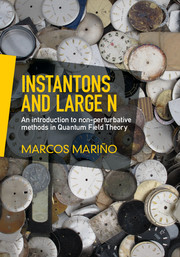Book contents
- Frontmatter
- Contents
- Preface
- Part I Instantons
- Part II Large N
- 6 Sigma models at large N
- 7 The 1/N expansion in Quantum Chromodynamics
- 8 Matrix models and matrix Quantum Mechanics at large N
- 9 Large N Quantum Chromodynamics in two dimensions
- 10 Instantons at large N
- Appendix A Harmonic analysis on S3
- Appendix B Heat kernel and zeta functions
- Appendix C Effective action for large N sigma models
- References
- Author Index
- Subject Index
8 - Matrix models and matrix Quantum Mechanics at large N
from Part II - Large N
Published online by Cambridge University Press: 05 September 2015
- Frontmatter
- Contents
- Preface
- Part I Instantons
- Part II Large N
- 6 Sigma models at large N
- 7 The 1/N expansion in Quantum Chromodynamics
- 8 Matrix models and matrix Quantum Mechanics at large N
- 9 Large N Quantum Chromodynamics in two dimensions
- 10 Instantons at large N
- Appendix A Harmonic analysis on S3
- Appendix B Heat kernel and zeta functions
- Appendix C Effective action for large N sigma models
- References
- Author Index
- Subject Index
Summary
Introduction
As we have seen in the previous chapter, the 1/N expansion leads to a new point of view in the study of YM theory and QCD, which captures some important aspects of their dynamics. However, quantitative results are difficult to obtain since we are unable to calculate the planar limit exactly, i.e. we are unable to resum all planar diagrams. In this and the next chapter we will consider toy models in lower dimensions where we can in fact perform such a resummation. We will begin by a drastic simplification: we will go from four to zero dimensions, and consider theories made out of constant fields in the adjoint representation of U(N), i.e. theories based on Hermitian matrices, also known as matrix models. In these models, the path integral reduces to a conventional multidimensional integral. One might think that they would be too simple to be relevant in any way to actual gauge theories. However, the problem of resumming the diagrams with a fixed topology in matrix models is still a non-trivial one, and has many applications in many branches of physics and mathematics. Moreover, it has been shown that some quantities in bona fideinteracting QFTs (albeit with some special properties, like supersymmetry) reduce to matrix models. Therefore, the problem of resumming the fatgraphs in matrix models has unexpected applications in the study of these highly symmetric QFTs, and the large Ntechniques we will introduce in this chapter are relevant in the study of these gauge theories.
A closely related class of toy models for large NQCD is matrix QM, in which one considers simple quantum mechanical systems (typically in one spatial dimension) and promotes the dynamical variables to Hermitian matrices. This system also has some interesting applications and provides a framework where one can use exact results in QM to give insights in the 1/N expansion.
Hermitian matrix models
Matrix models are in a sense the simplest examples of quantum gauge theories, namely, they are quantum gauge theories in zero dimensions in which the spacetime dependence has been removed.
Information
- Type
- Chapter
- Information
- Instantons and Large NAn Introduction to Non-Perturbative Methods in Quantum Field Theory, pp. 242 - 273Publisher: Cambridge University PressPrint publication year: 2015
